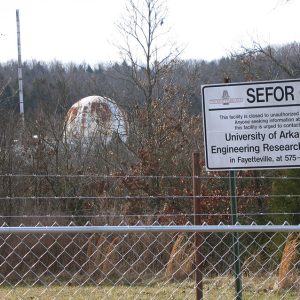calsfoundation@cals.org
Southwest Experimental Fast Oxide Reactor (SEFOR)
The Southwest Experimental Fast Oxide Reactor (SEFOR), which is located east of Strickler in rural Washington County, was completed in 1969 at the direction of the federal government, specifically the U.S. Atomic Energy Commission, to test the feasibility of breeder reactors in the production of electricity. It closed in 1972, and the University of Arkansas (UA) in Fayetteville (Washington County) took over ownership of the site in 1975 and conducted research at the facility until 1986.
A fast breeder reactor such as SEFOR uses fast neutrons for fission, making it possible for the nuclear reactor to produce more new fuel than it consumes, essentially “breeding” new fuel in the process. SEFOR was developed by a consortium of private energy companies, including General Electric, to test liquid-metal fast breeder reactor fuel, and it was used for that purpose from 1969 until 1972.
SEFOR demonstrated its worth by proving the feasibility of using plutonium as a fuel rather than uranium; it was the first reactor to do so. SEFOR never produced electricity (literature at the time said that “SEFOR is designed to operate up to 20,000 kilowatts,” being only heat) but was used strictly to conduct experiments by the consortium that had it built, which included the U.S. Atomic Energy Commission, General Electric, seventeen independent electric power companies, and the Federal Republic of West Germany as represented by Gesellschaft für Kernforschung. The energy produced by SEFOR heated the sodium in the sodium room and was then transferred to the radiator and released into the atmosphere. Unlike most nuclear reactors, which use water as both a coolant and as a circulating vehicle to take the heat away from the fuel area, SEFOR used liquid sodium, which was a more efficient coolant for circulating heat away from the fuel area. Water cannot be used as a coolant in a fast breeder reactor because it would absorb sufficient neutrons, making breeding impossible using uranium fuel.
Once the reactor was closed in 1972, the nuclear material was cleansed from the site. The University of Arkansas at Fayetteville took over ownership of the site in 1975 and conducted research at the facility until 1986, including a cooperative effort begun in 1978 with the National Bureau of Standards to develop SEFOR as a center for calibrating personnel dosimeters and health physics instruments used by the nuclear power industry.
Information gained at SEFOR has had far-reaching results. Many breeder reactors constructed around the world since SEFOR, including in the United States, have built on the principles learned through the experiments at the facility. In fact, much of the electricity produced today in Japan is produced by breeder reactors developed from information learned at SEFOR.
The future of SEFOR is in question. The Department of Energy has proposed decommissioning SEFOR, demolishing the facility and cleaning up the site to return it to its natural state. Although the nuclear material was removed from the site in 1972, the site is plagued by residual radiation and chemicals. In 2005, the federal government passed legislation to decommission and decontaminate the site. However, many years went by without any funding set aside for the project. Finally, in 2016, UA received a $10.5 million grant from the Department of Energy to begin dismantling SEFOR. Work began in March 2017 to assess the level of radioactivity remaining at the site.
In April 2019, it was announced that work to clean up the site was complete. In June 2023, UA announced plans to sell the property that includes the former SEFOR site. The UA Board of Trustees approved the sale on September 15, 2023.
For additional information:
Adame, Jaime. “Reactor Portion Left Underground.” Arkansas Democrat-Gazette, June 17, 2019, pp. 1B, 6B.
Anderson, Ryan. “UA Fayetteville to Sell Site of Ex-Breeder Reactor.” Arkansas Democrat-Gazette, June 27, 2023, p. 3B. Online at https://www.arkansasonline.com/news/2023/jun/27/ua-fayetteville-plans-to-sell-sefor-land/ (accessed June 27, 2023).
———. “UA Trustees Approve Sale of Ex-Reactor Site.” Arkansas Democrat-Gazette, September 16, 2023, pp. 1A, 2A. Online at https://www.arkansasonline.com/news/2023/sep/15/university-of-arkansas-sefor-property-to-be-sold-for-115-million/ (accessed September 18, 2023).
Architectural Survey Files for SEFOR (Site #WA0907). Arkansas Historic Preservation Program, Little Rock, Arkansas.
Brandon, William Edwin. “Wall Return of Californium-252 Neutrons at the SEFOR Calibration Center.” Ph.D. diss., University of Arkansas at Fayetteville, 1974.
Daniels, Alex. “Ex-Nuclear Plant Gathers Dust.” Arkansas Democrat-Gazette, August 19, 2007, pp. 1A, 6A–7A.
Golden, Alex. “Clean up of UA’s Atomic Reactor Site Done, Officials Say.” Arkansas Democrat-Gazette, April 23, 2019, p. 3B.
Havens, Jerry, and Collis Green. Thin Safety Margin: The SEFOR Super-Prompt-Critical Transient Experiments, Ozark Mountains, Arkansas, 1970–71. Fayetteville: Arkansas Scholarly Editions, 2021. Online at https://scholarworks.uark.edu/uapressasedit/1/ (accessed October 21, 2021).
Southwest Atomic Energy Associates. The Southwest Nuclear Research Center near Fayetteville, Arkansas. Little Rock: Unknown publisher, 1968.
Talebizadeh, Mohammed Ali. “Environmental Monitoring of Soil at a Decommissioned Nuclear Reactor, SEFOR.” Ph.D. diss., University of Arkansas, Fayetteville, 1984.
Young, Samantha. “Energy Bill Amendment Offered By Lincoln.” Fayetteville Morning News, April 10, 2002, p. 1A.
———. “Senate Approves SEFOR Amendment.” Fayetteville Morning News, April 19, 2002, p. 1A.
Ralph S. Wilcox
Arkansas Historic Preservation Program
 Divergent Prosperity and the Arc of Reform, 1968–2022
Divergent Prosperity and the Arc of Reform, 1968–2022 Environment
Environment Science and Technology
Science and Technology SEFOR Site
SEFOR Site 




Comments
No comments on this entry yet.